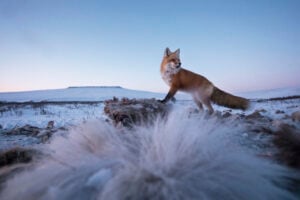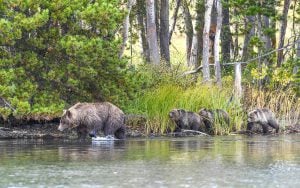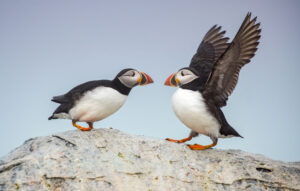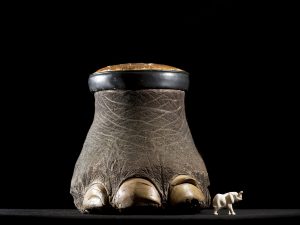
Wildlife
Do not disturb: Practicing ethical wildlife photography
Wildlife photographers on the thrill of the chase — and the importance of setting ethical guidelines
- 2849 words
- 12 minutes
Wildlife
“What are they doing and why are they here and what’s their story?”

Dr. Erin Ashe discovered her fascination for Pacific white-sided dolphins more than 10 years ago when a daunting white wall of rushing water along the horizon gradually advanced on her small boat. She didn’t know what it was at first, thinking it might be a squall.
And even as her now-husband and co-researcher Rob Williams pointed to the charging water, exclaiming, “Look, Lags!” Ashe still didn’t quite understand what she was seeing. It wasn’t until she peered through her binoculars that she realized the “wave” was actually hundreds of Pacific white-sided dolphins (Lagenorhynchus obliquidens, or Lags) crashing through the water, stirring up foam and whitewash, stampeding like an army into battle. Immediately, Ashe wanted to know their story.

Since then, the scientist and executive director of Oceans Initiative, a non-profit marine life conservation centre, has dedicated her career to these animals. Her research involves using photo-identification methodology to track the dolphin population off the northeastern coast of Vancouver Island in the Broughton Archipelago. The goal is to photograph each of the dolphins as they breach the water, ideally capturing photos of them from both sides. These photos can then be used by the researcher to identify individual dolphins based on the notches, scars, scratches and markings on their dorsal fins.
“Photo-identification is a great way to monitor a particular population year upon year,” Ashe explains. “You can look at the demographic component in relation to different environmental factors, like how the prey is doing or whether they’re affected by predation.”
Monitoring a concentrated population also allows Ashe to gather a detailed assessment of injury rates, how often females are calving, and whether they develop long-term, sociological relationships with others in their pod.
But while each dolphin is unique, just as each human is, it is very difficult to collect a high-quality, usable photograph of each animal when it’s part of a pod of several hundred. “That’s where we rely on statistics and different mathematical approaches to estimate things like abundance and survival and fidelity,” Ashe explains.


This photo-identification is hugely time-consuming and researchers are always conscious that human error is a challenge with a large group of similar-looking animals and photos that aren’t always razor sharp. If Ashe and her team are too cautious with their identification, avoiding pairing up certain photographs because they aren’t 100 per cent certain they’re the same dolphin, they risk concluding a larger-than-reality population. But if they’re too generous with their identification, their research risks erring on the side of a smaller-than-reality population estimate.

To reduce the possibility of inaccurate readings, Ashe has used a “certainty score” to better estimate various population abundances. Her 2022 study published in Mammalian Biology explained it succinctly: ‘Identified individuals within an encounter were matched and a certainty score of “Certain” (100% confident), “Likely” (< 100% but ≥ 90% confident), or “Possible” (< 90% but ≥ 50% confident) was assigned to putative matches between pairs of photographs based on the degree of confidence in each match.’ The researcher then took those certainty scores and used them to determine three different population estimates with minimal human bias.
Photo-identification is just as painstaking and labour intensive as it sounds — Ashe spends hundreds of hours scouring countless photographs to match dorsal fin to dorsal fin. It can take up to a year to go through a season’s worth of photos, with the resulting data then used to come up with population estimates. Until the 1990s, this photo-identification work was done with film cameras, with renowned American-Canadian marine biologist Alexandra Morton a major contributor.
“She was shooting on film at this remote base, and so she would shoot on film, then put the film on a float plane,” Ashe explains. The film would then go to a photo lab, which would send back contact sheets compiling all of Morton’s photos. The researcher would then have to look through a loupe (a special type of magnifying glass), picking out and circling which photos she wanted to get printed. Then she’d send her choices back on the float plane and wait for the photos to be printed and returned to her. “So that was a whole other level of love!” says Ashe.


Ashe, who works in the age of digital photography, has seen photo-identification advance quickly with more sophisticated technology — she’s carrying on that evolution with artificial intelligence.
Using algorithms that can match nick to nick and scar to scar on individual dolphin fins, this process significantly cuts down the time researchers spend bending over images, and also allows for collaboration between researchers and citizen scientists, who are encouraged to submit their own photos to researchers. While this program is still in its infancy, Ashe is hopeful that AI will be a valuable tool for researchers and help boost conservation efforts.

It all adds up to helping Ashe and other researchers keep ever-more-accurate tabs on a species that, while not currently endangered, is facing constant population shifts. Whether that’s due to predation, bycatch or changes in habitat distribution, Ashe is determined to avoid a “conservation by crisis” approach where extreme methods of preservation are only enacted at the crisis point when a species is facing extinction. “You don’t want to get into that position and it can happen really quickly,” she says.
Even after more than a decade, Ashe says she still has much to learn about Pacific white-sided dolphins. “As the world is changing, the environment’s changing, what I’ve learned … is that long-term datasets are worth their weight in gold.”
She wants to dive deeper into her unanswered questions about this species, like how they thrive and reproduce even while sharing the seas with predators such as orcas — and she believes photo-identification is the backbone to discovering those answers.
“The dolphin project represents this wonderful scientific curiosity and connection with nature. They have this ability to draw people in and really appreciate and connect with nature — and I think that’s something we all need right now more than ever.”
Are you passionate about Canadian geography?
You can support Canadian Geographic in 3 ways:

Wildlife
Wildlife photographers on the thrill of the chase — and the importance of setting ethical guidelines

People & Culture
These 10 members of Canadian Geographic’s online Photo Club are making waves with their unique perspectives on Canadian wildlife and landscapes

Wildlife
Canadian Geographic is pleased to honour 14 photographers for their outstanding images of Canadian wildlife

Wildlife
An estimated annual $175-billion business, the illegal trade in wildlife is the world’s fourth-largest criminal enterprise. It stands to radically alter the animal kingdom.